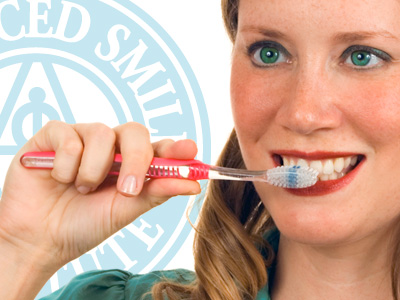With the proper education of preventative dentistry and basic dental procedures, patients can avoid or cease gum disease and other teeth related problems. At Advanced Smile Institute, patients can expect thorough preventive dentistry services with an experienced hygienist to help stop the development of oral disease and promote proper oral hygiene. Patients should incorporate preventative dental care into their daily routines at home and be sure to schedule a teeth cleaning at least once every six months to help maintain healthy teeth and gums. Dental hygienists at Advanced Smile Institute will search for early signs of periodontal disease, gingivitis, tooth decay and other gum or teeth problems that could lead to oral cancer. Our preventative dental care services include teeth cleanings, x-rays, oral cancer screenings, periodontal or gum disease diagnosing, fluoride applications, and other procedures to help prevent dental disease and remove plaque.
 An important part of preventive dentistry performed by dental professionals is educating patients about at-home care, nutrition, and smoking cessation. At-home procedures performed by patients that help ward off dental disease include regular and proper brushing, flossing and sometimes use of mouth rinses and at-home fluoride applications. Dentists and their staff thoroughly explain proper brushing and flossing techniques during teeth cleaning appointments.
An important part of preventive dentistry performed by dental professionals is educating patients about at-home care, nutrition, and smoking cessation. At-home procedures performed by patients that help ward off dental disease include regular and proper brushing, flossing and sometimes use of mouth rinses and at-home fluoride applications. Dentists and their staff thoroughly explain proper brushing and flossing techniques during teeth cleaning appointments.
Tooth Brushing
Proper brushing includes use of a soft nylon toothbrush with round-ended bristles. Patients should place the bristles along the gum line at a 45-degree angle to cover the tooth surface and gum line. The brushing technique should be gentle, always brushing away from the gums, with two to three teeth being brushed at a time. Patients should brush the inner surfaces of their teeth and tilt the brush vertically to brush the front teeth. Ideally, patients should use a back-and-forth motion to brush the biting surface of the teeth and the tongue.
Flossing
 Flossing removes plaque from between teeth and at the gum line. It should be done with an 18-inch strip of floss wrapped around the middle fingers of each hand. The remaining one to two inches of floss that is inserted between the teeth should be directed by the index fingers. By keeping the floss taut, patients can use their index fingers to guide the floss between the lower teeth with a gentle zig-zag motion, while contouring the floss around the sides of the teeth. They should floss each tooth with a clean section of the floss and ensure that the floss goes under the gum line.
Flossing removes plaque from between teeth and at the gum line. It should be done with an 18-inch strip of floss wrapped around the middle fingers of each hand. The remaining one to two inches of floss that is inserted between the teeth should be directed by the index fingers. By keeping the floss taut, patients can use their index fingers to guide the floss between the lower teeth with a gentle zig-zag motion, while contouring the floss around the sides of the teeth. They should floss each tooth with a clean section of the floss and ensure that the floss goes under the gum line.
Preventative Dental Care For All Ages
Preventive dental care should begin in infancy, within the first year of life before teeth first appear, and continue throughout life. Even before teeth erupt, parents can clean infants' gums after feeding. Preventive care in adolescence includes brushing and flossing, as well as wearing custom-made mouth guards to protect the teeth during contact sports. Considering that 75% of Americans have some form of dental disease, regular dental visits are particularly important for adults. Seniors often benefit from training in proper techniques of denture care and cleaning, which include brushing the replacement teeth. Those who have problems moving their hands because of arthritis, for example, also benefit from tips for adapting toothbrushes for easier handling.
